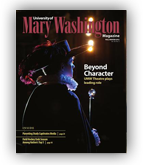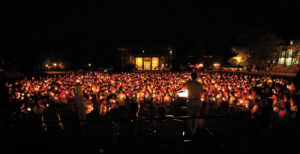The evening after the University of Mary Washington ushered more than 1,300 new undergraduates into a fresh academic year, a brilliant tradition began.
At the inaugural “Eagle Gathering” each student carried a candle and passed its flame to another, bringing a glimmering gold to the night on Ball Circle. The ceremony represented the “torch of knowledge” at the center of the UMW Seal.
“This light symbolizes the core values of our community,” President Richard V. Hurley told new students at the Thursday, Aug. 23, gathering. “It stands for the desire to learn, to grow, to serve, to lead, and in all things, to give our best in search of meaning and truth.”
The day before, with temperatures nearing 90 degrees, hundreds of freshmen embarked on a five-day orientation, lugging futons and air fresheners, Ramen and area rugs into Alvey, Virginia, Bushnell, Jefferson, Randolph, and Russell halls.
Of the new students – 978 freshmen and 324 transfers – 40 had already met at Pre-Flight, another new Mary Washington experience. The four-day program, held in the Virginia mountains before orientation officially began, was packed with outdoor adventures and volunteerism. The excursion gave participants a taste of teambuilding, a sample of UMW’s emphasis on service, and a boost in bonding with classmates.
experience. The four-day program, held in the Virginia mountains before orientation officially began, was packed with outdoor adventures and volunteerism. The excursion gave participants a taste of teambuilding, a sample of UMW’s emphasis on service, and a boost in bonding with classmates.
First-year students pledged at the Aug. 24 Honor Convocation to uphold Mary Washington’s ethical code. They also met with faculty advisers; attended sessions about UMW academics, campus life, and customs; and indulged in gooey scoops of ice-cold goodness at an ice cream social at the President’s home, Brompton.
By the time classes began on Monday, Aug. 27, UMW had welcomed freshmen from 28 states and several foreign countries. One hundred and fifty-eight are from 24 states outside of Virginia, including Connecticut, Maryland, Massachusetts, New Jersey, New York, North Carolina, and Pennsylvania. Twenty-four percent identify themselves as Hispanic or Latino, American Indian or Alaskan, black or African-American, Asian, or multiracial.
The newcomers performed well on SATs, with the middle 50 percent scoring between 520 and 630 in critical reading, 510 and 600 in math, and 510 and 610 in writing. The middle 50 percent scored between 22 and 27 on the ACT and graduated from high school with grade-point averages between 3.31 and 3.88.

